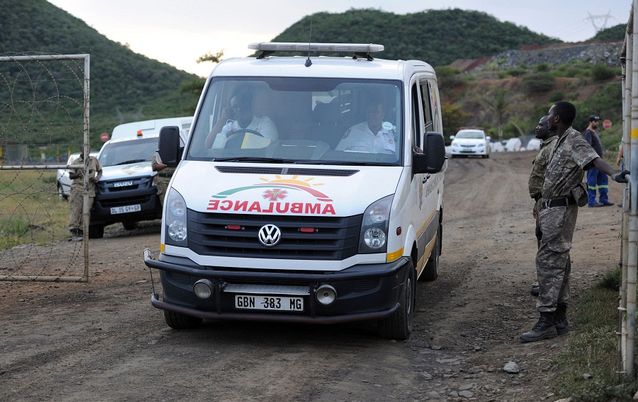THERE is a certain irony to the fact that the accident at the Lily gold mine of Vantage Goldfields occurred just days after Mineral Resources Minister Mosebenzi Zwane released the 2015 mine safety statistics, which showed that fatalities had fallen 8%.
The 77 workers who died last year were the fewest on record in SA, indicating how much the industry’s safety record has improved since 1994. The advances in recent years have demonstrated how mining companies, trade unions and regulators can work together to tackle the dangers and make a difference.
They have shown, too, how important it is that mining companies devote high-level attention and resources to safety. The safety record for Chamber of Mines members is now approaching levels typical of Australia and Canada, and the fact that the CEOs of mining companies meet regularly to address safety issues reflects the seriousness with which the large players are taking the issue.
But it was not always that way and SA’s mining houses have had to make an effort as tolerance for safety lapses has waned globally.
And there is still a long way to go, as the Lily mine drama would seem to emphasise. But in trying to learn Lily’s lessons, it is important not to jump to conclusions, as some nongovernmental organisations have done.
The only way to answer how and why the accident occurred would be through an independent investigation.
And it is important that the findings are communicated to the public just as transparently as the daily rescue efforts at the Lily mine have been.
It is crucial to keep in mind, however, that the disaster at the Australian-owned mine was not a mine accident in the conventional sense.
In contrast to the rock falls or seismicity that are involved in most mine accidents, this was a different and unusual case. A container that was being used as an office crashed down a sinkhole, trapping the miners who were at work in the mine as well as the three office workers in the container.
The investigation will no doubt look at why the sinkhole opened up and whether the mine’s design contributed to it. This is an issue deserving of more attention in those areas of SA which historically have been heavily mined.
Tragic as the accident was, however, there is much that was good about the way so many rallied round to support the mine and the workers.
That all the workers, except for the three trapped in the container, were rescued so rapidly and so efficiently is a tribute to the heroic work of SA’s mine rescue services.
This dedicated and highly skilled volunteer corps, drawn from all of SA’s mines, doesn’t get nearly enough credit for the amazing work it does in rescuing mine workers whenever accidents occur.
Equally, it has been heartening to see the support which the small Lily mine and its people received from a wide range of stakeholders. They included trade unions and high-level support from Mr Zwane and the Mpumalanga premier, as well as from the Chamber of Mines (of which Vantage Goldfields is not a member).
Support came, too, from many concerned members of the public.
Mine accidents tend to attract attention, and criticism. But safety records can be just as bad, if not worse, in other industries, such as construction. Stakeholders in those industries need to do a lot more to work together to invest in improving their safety records.
It’s usually the dramatic accidents with deaths or large numbers of injured that garner the most attention. But almost every day there are smaller incidents that make for disturbing trends when tallied together.
In the case of the Lily disaster, there are positive lessons to be learned in the support and rescue efforts. The latest mining safety stats also offer some relief. The industry must build on that.

Security marshalls open the gates for an ambulance to leave the Goldfields Lily Mine in Barberton in the South African Mpumalanga province after a gold mine collapsed earlier this month. Picture: AFP/STRINGER
THERE is a certain irony to the fact that the accident at the Lily gold mine of Vantage Goldfields occurred just days after Mineral Resources Minister Mosebenzi Zwane released the 2015 mine safety statistics, which showed that fatalities had fallen 8%.
The 77 workers who died last year were the fewest on record in SA, indicating how much the industry’s safety record has improved since 1994. The advances in recent years have demonstrated how mining companies, trade unions and regulators can work together to tackle the dangers and make a difference.
They have shown, too, how important it is that mining companies devote high-level attention and resources to safety. The safety record for Chamber of Mines members is now approaching levels typical of Australia and Canada, and the fact that the CEOs of mining companies meet regularly to address safety issues reflects the seriousness with which the large players are taking the issue.
But it was not always that way and SA’s mining houses have had to make an effort as tolerance for safety lapses has waned globally.
And there is still a long way to go, as the Lily mine drama would seem to emphasise. But in trying to learn Lily’s lessons, it is important not to jump to conclusions, as some nongovernmental organisations have done.
The only way to answer how and why the accident occurred would be through an independent investigation.
And it is important that the findings are communicated to the public just as transparently as the daily rescue efforts at the Lily mine have been.
It is crucial to keep in mind, however, that the disaster at the Australian-owned mine was not a mine accident in the conventional sense.
In contrast to the rock falls or seismicity that are involved in most mine accidents, this was a different and unusual case. A container that was being used as an office crashed down a sinkhole, trapping the miners who were at work in the mine as well as the three office workers in the container.
The investigation will no doubt look at why the sinkhole opened up and whether the mine’s design contributed to it. This is an issue deserving of more attention in those areas of SA which historically have been heavily mined.
Tragic as the accident was, however, there is much that was good about the way so many rallied round to support the mine and the workers.
That all the workers, except for the three trapped in the container, were rescued so rapidly and so efficiently is a tribute to the heroic work of SA’s mine rescue services.
This dedicated and highly skilled volunteer corps, drawn from all of SA’s mines, doesn’t get nearly enough credit for the amazing work it does in rescuing mine workers whenever accidents occur.
Equally, it has been heartening to see the support which the small Lily mine and its people received from a wide range of stakeholders. They included trade unions and high-level support from Mr Zwane and the Mpumalanga premier, as well as from the Chamber of Mines (of which Vantage Goldfields is not a member).
Support came, too, from many concerned members of the public.
Mine accidents tend to attract attention, and criticism. But safety records can be just as bad, if not worse, in other industries, such as construction. Stakeholders in those industries need to do a lot more to work together to invest in improving their safety records.
It’s usually the dramatic accidents with deaths or large numbers of injured that garner the most attention. But almost every day there are smaller incidents that make for disturbing trends when tallied together.
In the case of the Lily disaster, there are positive lessons to be learned in the support and rescue efforts. The latest mining safety stats also offer some relief. The industry must build on that.




















Change: -0.47%
Change: -0.57%
Change: -1.76%
Change: -0.34%
Change: 0.02%
Data supplied by Profile Data
Change: -1.49%
Change: 0.00%
Change: -0.47%
Change: 0.00%
Change: -0.08%
Data supplied by Profile Data
Change: 0.48%
Change: 0.86%
Change: 0.28%
Change: -0.22%
Change: 0.93%
Data supplied by Profile Data
Change: 0.25%
Change: -0.21%
Change: 0.20%
Change: -1.22%
Change: -1.21%
Data supplied by Profile Data